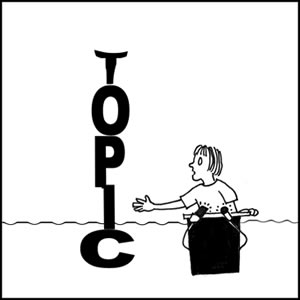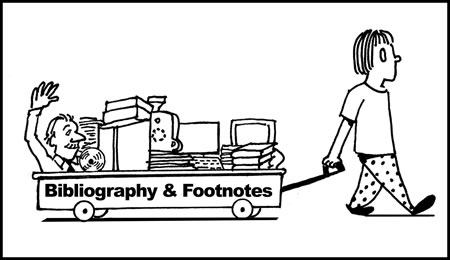

|


Watch the "three ways" video and read the info below.
1. Your teacher will assign a specific topic.
For example, you may be asked to write a research paper about bats which includes information on where they live, what they look like, their prey and predators. Even when you are given specific guidelines, your teacher may tell you to include a section on "other interesting facts" which you will select.
2. You will be given a general topic and you will have to focus in on some part of that topic.
For example, your class may be learning about people from different countries. Your teacher may give you the option of selecting any country. He might give you twenty possible questions from which you can select those which you would like to research.
3. You will be given complete freedom to select a topic of your own.
You can select a topic about which you are passionate -- or -- you might wish to get out of your comfort zone. Could there be something out there just waiting to be discovered -- something you haven't met in your travels so far? |


Once you select your topic, you will begin searching for research resources.
Getting Started
The best place to start is by looking up your topic's keywords in an encyclopedia or dictionary.
You can use hardcopies and/or internet versions of these resources. Most school libraries and public libraries have subscriptions to reference books on the web.
Ask a Person!
Don't forget to ask your teacher, librarian, and parents to help you find information about your topic.
Is the Information Reliable?
- Does the information come from a credible source?
- Is the information current?
- Is the information free of errors?
- Is the information objectively written?
- Does the resource properly cite its original sources?
Some Information Resources
- Interviews
- Trade Books
- Textbooks
- Primary Source Documents
- Scholarly Journals
- Newspapers
- Encyclopedias
- Dictionaries
- Magazines & Journals
- Lectures & Presentations
- Websites (Search Engines)
- CD ROM
- Videos
- Digital Images
- Databases - free and for a fee
|


Your first goal is to gather some basic information about your topic so that you can start writing your "introducing my topic" paragraph or thesis statement.
This basic information will also help you to develop the "guiding questions" for your research paper.
Here are some ways to become familiar with your topic quickly and to gather "keywords" that will help you when you are searching for information on the internet.
1. Select a few books and review the Table of Contents -- you should notice some sections that are covered in all of the books.
2. Browse through the books -- read the section headings and captions under pictures, tables and graphs.
3. Visit the Glossary and read the definitions of unfamiliar words.
4. Take a look at the index. The index is another great place to find keywords for your search.
5. Look at the bibliography. You may wish to look at some of the resrouces used by the author(s). If the resource you are reviewing is a reliable resource, then the bibliography will likely provide a list of additional reliable resources.
As you gather more information, you may decide to add to or change your introduction. You may also wish to change or add to your guiding questions.
|

The introduction to your research paper (thesis statement) tells people why you selected your topic, identifies the purpose of your research, and gives a preview of your paper's main ideas.
Include the following:
1. What makes this topic interesting?
2. What will you teach others?
3. What are your opinions about this topic?
4. What are you trying to prove?
Click Camera for examples of excellent thesis statements.  |


Your guiding questions will help you to focus your research. Be sure to have your teacher review your guiding questions before you begin.
Your guiding questions should not be too broad or too narrow. What does this mean? Let's say you've chosen the topic the human heart.
A question which is too broad would be "How does the heart work?"
A question which is too narrow would be, "How big is a human heart?"
Just right questions might be, "What can a person do to have a healthy heart?" or "What are the major functions of the heart?"
Three to five just right guiding questions are usually enough to write a focused research paper. It's OK to have one general question, "What are some other interesting facts, about the human heart?", just in case you find some amazing tidbits of information that you would like to share. In fact, one of these interesting facts could become the topic of your next research paper! |

 What is a citation? What is a citation?
A citation is used for two important purposes:
- It documents the sources you used write your research paper
- It gives your reader information to find that source again.
When Should You Use a Citation?
- Whenever you use quotes
- Whenever you paraphrase
- Whenever you use someone else's ideas
- Whenever you mention the work a resource
- Whenever your ideas were influenced by someone else
The Citiation Helper included in the Reserach Project Organizer under Bibliography makes writing citations for books, magazines and websites easier. You can try the Citation Helper below. We will practice writing citations in the library as group; you will practice on your own and your work will be reviewed for accuracy; finally, you will use the Citation Helper when you write your research paper.
|


Once you have gathered your resources and identified your guiding questions, you will be ready to read with a purpose.
Your notes should record only ideas that address your guiding questions.
Here is a great demo on recording "note fragments"
Fact Fragment Frenzy (Click on Demo)
Remember, you must include a citation for each of your notes -- quoted text, paraphrased text, and "snippets" of facts gathered from your research resources.
|
 Research Project Organizer Research Project Organizer
 Were you ever asked to complete a task that seemed overwhelming? Perhaps you didn't know where to begin -- so you didn't begin at all. Were you ever asked to complete a task that seemed overwhelming? Perhaps you didn't know where to begin -- so you didn't begin at all.
Well, I'll tell you a secret. Every task, no matter how challenging, can be turned into a manageable set of smaller tasks.
That is how I created the Research Project Organizer which you will use to write your research paper.
I did the work which made the process of writing a research paper manageable and easy to understand.
I used systems thinking, structural decomposition, and top-down design to break the big task of writing a research paper into smaller, manageable tasks.
There's more to come on how you can use these ways of thinking. |

 More Ways to Share! More Ways to Share!
After you complete a Research Paper, you can share your work in many different ways.
You can use the information in your paper to:
Write a:
Story, Song, Play, Comic Strip, Newspaper Article, Letter to a Friend, Poem, Reader's Theater Play
Create a:
Brochure, Powerpoint Presentation, Drawing, Podcast, Video Report, Website
Use your voice:
Give a Speech, Give an Oral Report, Sing a Song, Recite a Poem
|
|
Bookmarks
POSTERS
Select a Topic
Find Resources
Get to Know
Introduce
Guiding Questions
Bibliography
Taking Notes
Writing
Sharing
|